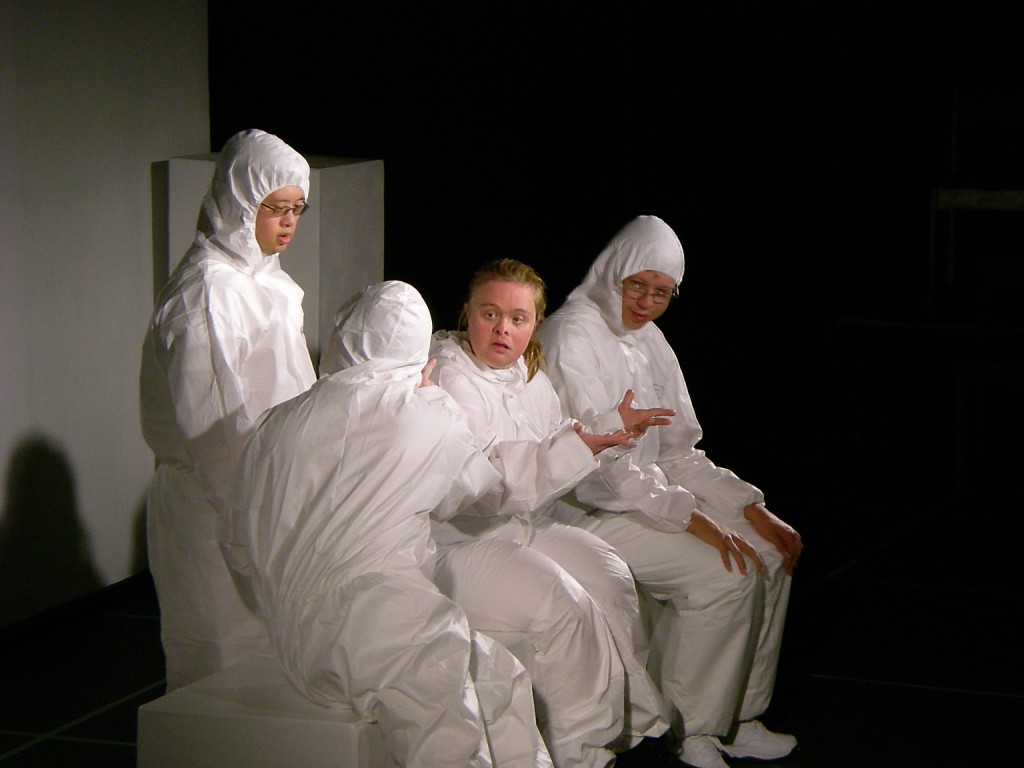City of Control - performance of joy

City of Control is a science fiction story that borrows heavily from George Orwell's 1984. Instead of Big Brother we get a sort of Big Sister - called Control - whose face appears as a giant projection against the back wall of the small theatre. (It was fantastic to see this small space in the basement of Heritage Hall on Main Street used once more).
Control tells the city residents - all dressed in white overalls with hoods - what to do, where to go and when to exercise. So far, so Fringe - but what makes this parable of conformity different is that all 17 (yes, 17) of the performers are in some way developmentally challenged. One of the conventions of theatre that includes performers who are differently-abled is that there are often professional, fully-abled performers on stage to provide ballast and support. City of Control chose not to go this route and I think it is the stronger and more effective for it. City of Control creates a coherent, alternative reality; with no professional actors to act as a sort of guide or touchstone, you immediately start to wonder who exactly is doing the controlling and to whose standards are these individuals conforming? Is it the wider community outside the performing space?
With its army of performers in white suits (only differentiated by black badges), a set that is nothing but versatile white cubes, and the omnipresent screen (projections were used just the right amount) - City of Control looks rather cool. The almost blinding whiteness is key because colour - representing difference or diversity - is important to this story. There is a rebel group who want to restore the king and queen and they leave small coloured cubes as a sort of calling card of their presence. These small, colourful squares are effectively used and there is a neat twist at the end when one of the rebel leaders - the battle won - leaves a slightly altered version of the calling card. The audience is left pondering the perpetual nature of rebellion and - I suppose - conformity.
The story provides a neat parable for those who face physical and mental challenges in our society and the need for conformity or blending in, whatever our individual abilities. The success and charm of this piece lies in the performances, however, which ranged from soft spoken conviction that drew me right in, through to energetic delight at being on stage to the complete, compelling silence of one performer. There are also effective sequences, including a lovely romantic subplot, some slapstick comic business and a sort of talent contest towards the end. After a month of furrowed-browed seriousness in Toronto, it was refreshing to see performers actually enjoying and delighting in their experience on stage. Control, naturally, is destroyed and the people - at least momentarily - are set free. They pull back their hoods and we can see the individuals clearly, their identities are more obvious to us. This simple conceit worked beautifully and I found myself studying all the faces as closely as possible before they left the stage.
At the end, the performers made their way through the theatre and shook hands with the audience. This is only my first show at the Fringe this year, but I wonder if that moment of connection and tenderness will be topped by anything else I'll see. Authenticity seems to be a re-occurring theme in theatre at the moment. There's an authentic experience for you, I suggest you take it in.
For more information and show times, please go here.



